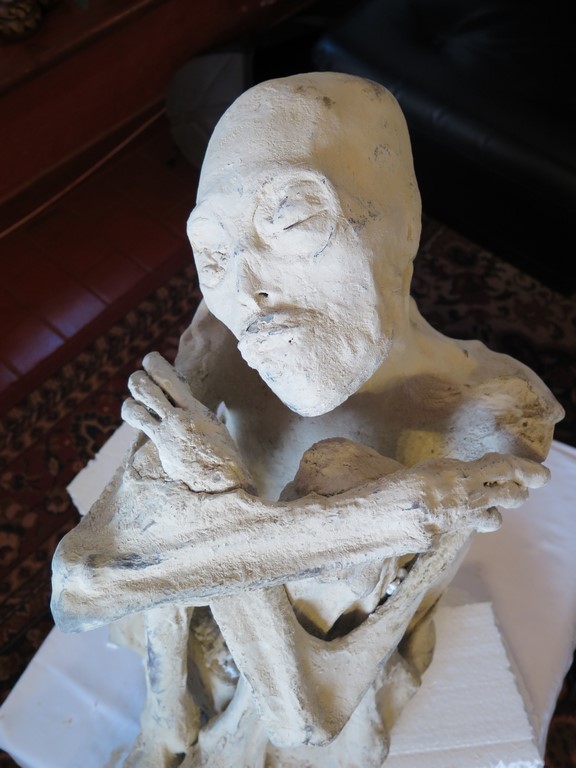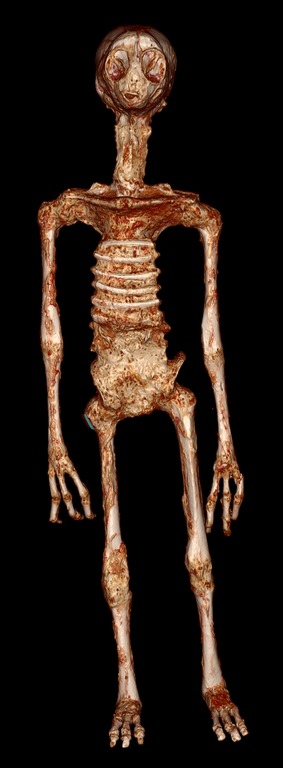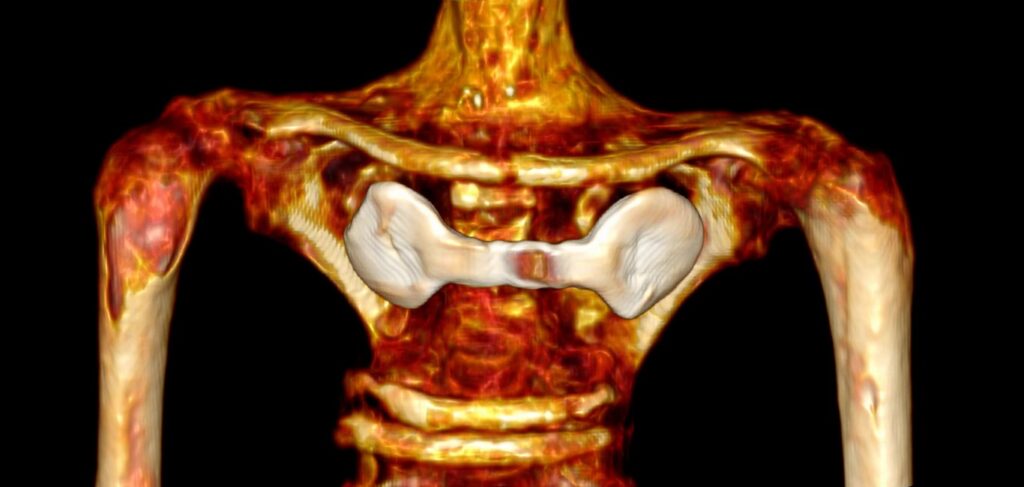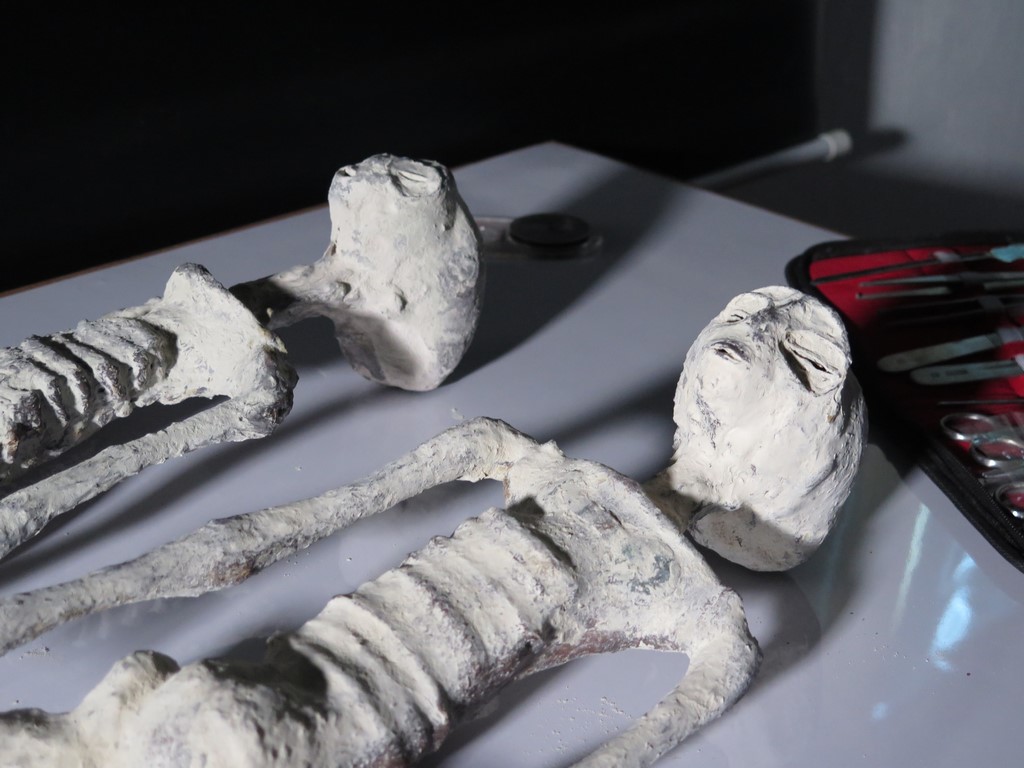
This seemingly extravagant affair began with a revelation made in October 2016 to a French explorer, Thierry Jamin, founder of the Peruvian Institute Inkarri-Cusco, an NGO dedicated to archaeological research. This specialist in pre-Columbian civilisations was contacted by tomb robbers, or huaqueros. They wanted his opinion on mysterious mummified entities found in the Nasca-Palpa area of Peru. One of these grave robbers brings him a "funny little humanoid creature with three fingers" measuring 24 cm, with a little head that looks like E.T., then a dried-up hand with three fingers, 39 cm long. Jamin finds himself plunged into an incredible adventure that not only stirs up passions but also raises serious questions about the history of mankind.
Convinced that the biological material he had been given was real, Jamin spent weeks trying, not without difficulty, to make contact with the chief of the huaqueros, Mario (1), who was behind the discovery. The aim is to try and preserve this precious material, prevent it from being sold to collectors and study it scientifically by involving the Peruvian authorities. "With patience, we have succeeded over time in gaining Mario's trust. Thanks to this special relationship, we were able to study many of the mysterious bodies found by him and his companions in the Nazca desert, just a few hundred metres from the enigmatic giant figures carved into the ground", he explains.
Humanoid-looking bodies
Jamin learns that, in underground galleries, the huaqueros discovered stone chests containing mummified organs (tridactyl hands, heads, brains) and complete bodies of all sizes, seemingly belonging to different species of unknown origin, all preserved in a whitish powdery solution that was later identified as diatomaceous earth with antiseptic properties. In all, more than twenty complete bodies were found there, according to Mario. They ranged in size from around 20 cm to 1 m high. Jamin and his team, supported by numerous international experts, studied around twenty of them.
Mario also revealed that he had found hundreds of small stones carved into the sarcophagi, some depicting elongated faces with almond-shaped eyes, objects reminiscent of UFOs and stones representing various animals.
He also admits to having sold some of these artefacts, as well as biological elements (hands, mummified brains) to collectors around the world. He also reveals that, during their excavations, they came across small living humanoid entities measuring around forty centimetres in height, which fled when they saw them. What are we to make of these testimonies, which would seem to indicate that unknown creatures are still living on the site? The enigma remains.
Alien Project
Since the huaqueros delivered the first bodies and pieces of mummies to Thierry Jamin and his team, the researchers have been examining the relics, having them analysed by scientists in several countries to eliminate any risk of fraud and to ensure that the biological material is indeed authentic. The fact remains, however, that DNA analysis and Carbon-14 dating of these mummies comes at a price. Hence the idea of a crowdfunding campaign on the Ulule platform called "Alien Project" (2). The fund-raising operation, launched in 2017, was a success and the studies could begin. But the discovery of these strange humanoids also triggered passionate reactions on the Web, many of which were based on conjecture, belief or people who had never travelled to see for themselves.
New deliveries
In February 2017, the Inkarri team received two perfectly preserved mummified heads, looking like aliens, of the type "Little greys" . The skull is elongated, with no hair or ears, a barely visible nose, a tiny mouth and two large almond-shaped eyes, closed by slanted eyelids. Are these authentic relics or have they been "manufactured"? X-rays show no trace of fraud.
Three large, severed tridactyl hands follow, made up of long fingers with six phalanges ending in fingernails. On the top of two of the hands are mysterious circular golden metal plates, each covered with geometric signs.
What was the purpose of these plates placed in the centre of the palm? To control certain devices? Or to pilot a spaceship? Is there a link between these mummies and the UFO phenomenon? The hypotheses are wide open! The fact remains that if we apply a ratio comparable to human anatomy, these creatures must have been over 2.40 m tall. To what species, unknown to science, did these bodies belong?
Albert, a species closely related to reptiles?
In March 2017, another mummified biological entity will be handed over to the Inkarri Institute by Mario. At 60 cm tall, it looks like something out of a Spielberg film, "Meeting of the third type". The body is intact; the hands have three fingers with three phalanges, while the feet have three toes with four phalanges. The spinal column has 28 vertebrae and the thorax has 8 circular ribs, two of which are floating. The clavicles are replaced by a transverse bone, the furcula, a bone found in birds and dinosaurs that resulted from the fusion of the two clavicles during evolution. The X-ray also revealed a 2 cm round metal object embedded in the right hip, like an implant. This dried-up little creature, named "Albert", astounded the researchers. And raised a host of questions? Where does it come from? What species does it belong to? Is it a hoax?
The body, examined by three renowned Peruvian surgeons, is made up of bones, tissues and joints, and does not appear to be a sham in the eyes of the doctors. We have to face facts: it is a biological organism that lived at a given moment in our history and about which we know nothing.
Josefina, humanoid reptile
A few weeks later, Mario returned with another entity described as "female" by its discoverer, 4 dehydrated brains and several metal, stone and bone objects. Named Josefina by Thierry Jamin, the last entity to be delivered was indeed a 58 cm "female" with tridactyl hands comprising four phalanges. Its skull is elongated and elliptical, as in "Albert". Its abdomen is rounded and its thorax comprises nine pairs of fixed ribs and two pairs of floating ribs articulated around a spinal column that is not flush with its back as in humans, but is set back a few centimetres. This means that the junction between the spinal column and the skull is not at the back of the neck as in humans, but rather in the centre of the trunk. A copper breastplate is fitted to her chest and she has no mammary glands. It does not belong to the order of mammals. X-rays and scans reveal that its bones are hollow, a feature found in birds. But the most astonishing feature is its reproductive system. There are four oval-shaped gestating eggs in its abdomen, three of which are calcified and one is developing. This would seem to confirm a reptilian origin. The complete reproductive system ends in a cloaca that will release the eggs, as in ovoviviparous and oviparous species. The circumstances of its death are undetermined.
According to Dr José de Jesus Zalce Benitez, a forensic pathologist who worked for the Mexican army for 30 years, the body is truly desiccated and he rules out any possibility of fraud. As for biologist Dr José de la Cruz Rio Lopez and his colleagues who studied the two mummies, Josefina and Albert do indeed belong to an unknown species of reptilian humanoids.
Maria, the hybrid mummy
The discoveries don't stop there. In April 2017, the trafficker in archaeological objects handed over to the team at the Instituto Inkari - Cusco with a new three-dactyl biological entity called Maria. She is in the fetal position, her hands crossed at the top of her chest over her bent legs, and was thought to be 1.70m tall. She appears to be female, as confirmed by a dozen international experts, including Dr Konstantin Korotkov, a specialist in physics, biophysics and medicine who travelled specially from St Petersburg to examine her. She was aged around 45 and her death appeared to be natural. "No fraud has been detected in the tridactyl hands and feet, and all the scans confirm that the body has not been modified or altered, either recently or in the past , it is authentic", says Dr José de la Cruz Rio Lopez. DNA analysis shows that Maria has 33.67 % of DNA in common with Homo sapiens, 46 % of unknown origin and 17.5 % due to bacterial contamination. "Maria is not human. We are dealing with a kind of hybrid", concludes the Genetech laboratory. Carbon-14 dating shows that it lived around 280 AD, at the height of the Nazca civilisation. Although its shoulder blades and the number of vertebrae (26 vs 32) do not match those of the human species, its skull has the same structures as those of humans, but its cranial capacity is greater (1650 cm3 compared with 1400 in humans). The encephalon is present inside the cranium and the dura mater can be distinguished. But the mystery of its origins remains. It is hard to imagine that this complete body with all its organs in place could be a fake or have been reconstituted by a grave robber. For all the scientists who spoke about this case at the "Nazca Conference" on 19 November 2018, it is unthinkable, and the only way to explain it is to ask them. "The innumerable examinations carried out on the entities by numerous international specialists, the X-rays, scans, DNA and Carbon 14 analyses carried out in ten or so countries around the world, show that these are indeed entities that lived on Earth at an ancient time in the history of mankind".
Victoria, a fourth reptilian entity
A month after handing Maria over to the Inkarri Institute, Mario brought in a new 'grey' biological entity called Victoria. Buried in a sitting position, the little body has no head and its hands rest on its knees. But the most intriguing feature is the well-preserved skin on its back. Greyish brown in colour, it bears a striking resemblance to that of a lizard or snake. It is also thought to belong to the order of reptiles. Carbon-14 dating shows that it lived between 791 and 1040 AD. And a study of its DNA suggests that it shares between 14 % and 36 % with modern humans, depending on the laboratory. What's more, after comparing her genome with more than a million animal species in various genetic databases, Victoria does not belong to any animal species listed to date. This rules out a reconstruction using human or animal bones, as some critics have claimed.
Three other specimens, similar to Josefina, Albert and Victoria, known as "la Familia", will be added to those collected. These specimens were returned to Mario under pressure and threats from the trafficker. You can imagine that they now sit in a collector's window. The Peruvian Minister of Culture was warned by Jamin in January 2017 about these discoveries and the risk of looting important archaeological sites. But to date, the researcher has received no response.
Authentic remains of unknown origin
We are therefore dealing with two different species. One described as reptilian, the other as hybrid. As a result, we are faced with a great mystery. And while it is impossible to affirm that these mummies are of exogenous (extraterrestrial?) origin, studies show that they belong to two species unknown to modern science. (2) Was there ancient contact between pre-Hispanic populations and non-human beings? Could a terrestrial lineage of these different beings have evolved alongside Homo sapiens, living in underground galleries?
The fact remains that the various bodies and parts of entities studied are between 1,800 and 750 years old! And more than 7,000 years old for the large tridactyl hands, according to two independent laboratories.
Since the "Nazca Conference" on 19 November 2018, the arguments of the detractors of this incredible affair have been shattered. Indeed, the hypothesis of an arrangement with other known species, human or animal, would imply the presence of traces (lesions, scars, etc.). "What surgical devices or tools could have been used so subtly that our modern scanners would not detect the scars left on these bodies? This would presuppose a level of technology and knowledge incompatible with the antiquity of these biological entities, as well as resources that are a priori unavailable even today. It would also imply the existence of biotechnology laboratories at the cutting edge of research in the Nazca desert? nearly two thousand years ago!says Thierry Jamin.
Finally, if the bodies of these strange mummies had been reconstructed from human or animal remains, the DNA analyses would have shown this quite quickly and without any doubt. In this hypothesis, after eliminating the "contaminated" DNA, the results would logically have concluded either that the DNA was 100 % Homo Sapiens, or that it was animal DNA. But this is not the case. Analyses carried out over many months, in particular on the mummies of Maria, Victoria and Josefina, in various laboratories around the world, show that they are absolutely authentic and belong to two species unknown in modern scientific literature. Their distant kinship with Homo Sapiens, whose shared DNA ranges from 19 to 35 %, should sooner or later lead researchers around the world to reconsider the official history of our own species.
In September 2023, X-rays and scans were taken of 2 specimens in a hospital in Mexico City. The team of specialists present confirmed their authenticity.
Olivier Sire, a lecturer and researcher in biophysics at the University of Southern Brittany (France) and an expert at the Court of Appeal in Rennes (where he studies data for medical and environmental expert reports), has studied samples of these mummies. If for him "the question of the origin of these mummies remains open". However, it concludes that : "These samples were indeed of biological origin and there is no doubt about it, they are not plastic, chewed cardboard or anything else. They were indeed signatures of organic molecules, proteins, ions, minerals, fats, sugars, etc., specific to the tissues extracted from the fragments identified" . However, it should be pointed out that these cannot be known animals either, as there is nothing to suggest that they are. So, are we dealing with a totally unknown species or extraterrestrial individuals? https://www.inexplore.com/articles/momies-nazca-perou-loupe-temoignage-biologiste
Those who have studied and analysed the various specimens (at least five of two different species) are convinced that these bodies are authentic, with evidence to back them up, while the detractors, who have neither approached nor studied them, are convinced of the opposite.
(1) This is an assumed name.
(2) The full results of the analyses carried out on the mummies can be consulted at www.the-alien-project.com
Read The non-human mummies of Nazca? A historic event. Thierry Jamin. Editions Atlantes. https://www.editions-atlantes.fr/c/auteur/thierry-jamin/
Find out more Interview with Thierry Jamin https://universvoyage.com/lorigine-extraterrestre-des-momies-de-nazca-est-lhypothese-la-plus-probable-entretien-avec-thierry-jamin/
Part of this article appeared in Inexploré in October 2022. https://www.inexplore.com/articles/nazca-etrange-histoire-momies-non-humaines-decouvertes-perou
Text: Brigitte Postel
Photos: Thierry Jamin

















